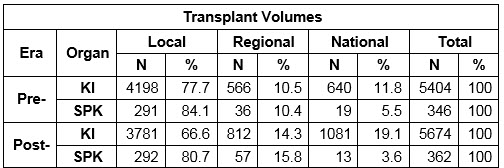How Did the New Kidney and Pancreas Allocation Systems Effect Pancreas Utilization in the First Six-Months?
1UNOS, Richmond, VA
2Indiana Univ School of Medicine, Indianapolis, IN
3Univ of Wisconsin Hospital and Clinics, Madison, WI
4Univ of Iowa Hospital and Clinics, Iowa City, IA.
Meeting: 2016 American Transplant Congress
Abstract number: 298
Keywords: Allocation, Kidney transplantation, Kidney/pancreas transplantation, Pancreas transplantation
Session Information
Session Name: Concurrent Session: Clinical Pancreas Transplantation 1
Session Type: Concurrent Session
Date: Monday, June 13, 2016
Session Time: 4:30pm-6:00pm
 Presentation Time: 4:42pm-4:54pm
Presentation Time: 4:42pm-4:54pm
Location: Room 309
Background: In 2010 a new pancreas allocation system (PAS) was approved by the OPTN and implemented in October 2014, shortly preceding the new kidney allocation system (KAS). This system combined pancreas and simultaneous pancreas-kidney (SPK) candidates onto one match-run, added qualifying criteria for SPK waiting time, and set the kidney to follow the pancreas nationwide. Post-implementation, the OPTN pancreas committee studied the impact of the new PAS and KAS.
Methods: Using OPTN data from 6 months post-KAS implementation (12/4/14 – 6/4/15) and the same time-period from the prior year, the analyses show the impact on deceased donor pancreas and kidney utilization by pancreas and kidney donor risk indexes (PDRI and KDRI) and other factors. Odds of recovery and discard for donors were used to test utilization trends, and changes in proportions were studied for trends in volumes.
Results: Utilization of pancreas did not change. Kidney recovery rates have increased for KDPI<35% and decreased for KDPI>85%. Sharing of kidneys for adult transplants have increased significantly post-implementation (p<0.01), and regional adult SPK transplants have increased (p=0.06). SPK transplants are being performed on recipients further on the match run than pre-implementation (p=0.03). The proportion of kidney transplants that are SPK remained constant post-implementation as pre- (~5.5%).
 Table 1. Volume of Adult SPK and KI transplant volume by share type.
Table 1. Volume of Adult SPK and KI transplant volume by share type.
Conclusions: Despite an increase in national volumes of deceased donors and transplants within the 6 month period following KAS implementation, pancreas recovery rates remain constant. The increase in regional SPK transplants has not resulted in fewer local transplants and OPOs place SPKs further on the match-run than before. PAS has not interfered with kidney allocation, using the same % of kidneys for SPK as in the past.
CITATION INFORMATION: Carrico R, Fridell J, Odorico J, Stewart Z. How Did the New Kidney and Pancreas Allocation Systems Effect Pancreas Utilization in the First Six-Months? Am J Transplant. 2016;16 (suppl 3).
To cite this abstract in AMA style:
Carrico R, Fridell J, Odorico J, Stewart Z. How Did the New Kidney and Pancreas Allocation Systems Effect Pancreas Utilization in the First Six-Months? [abstract]. Am J Transplant. 2016; 16 (suppl 3). https://atcmeetingabstracts.com/abstract/how-did-the-new-kidney-and-pancreas-allocation-systems-effect-pancreas-utilization-in-the-first-six-months/. Accessed December 16, 2025.« Back to 2016 American Transplant Congress
